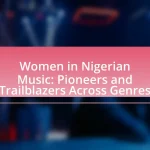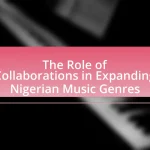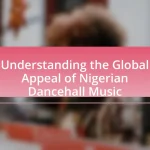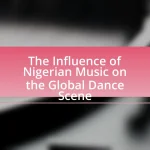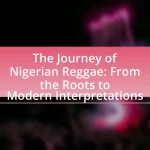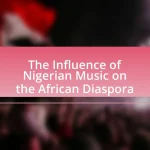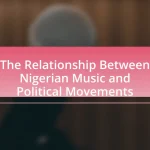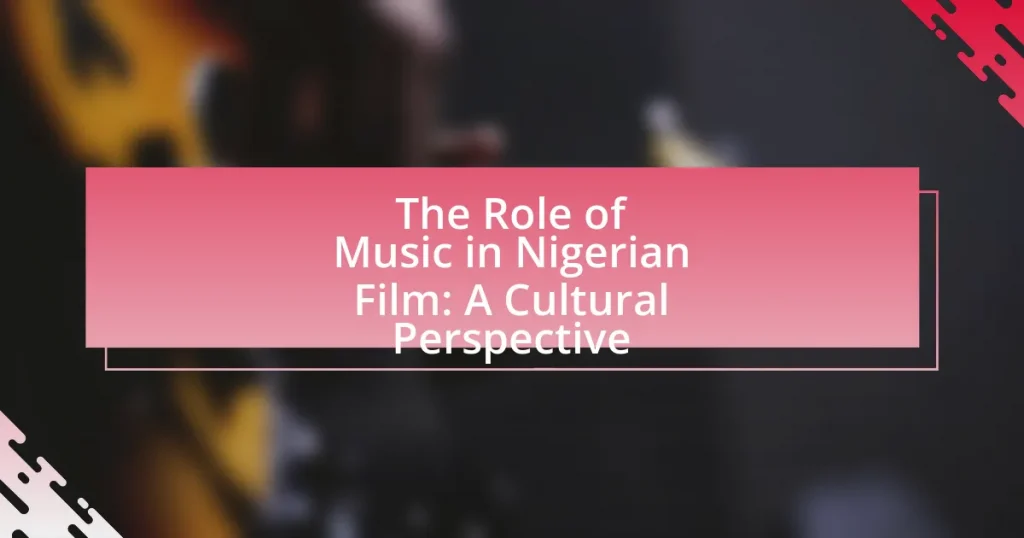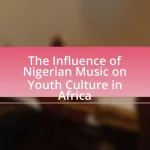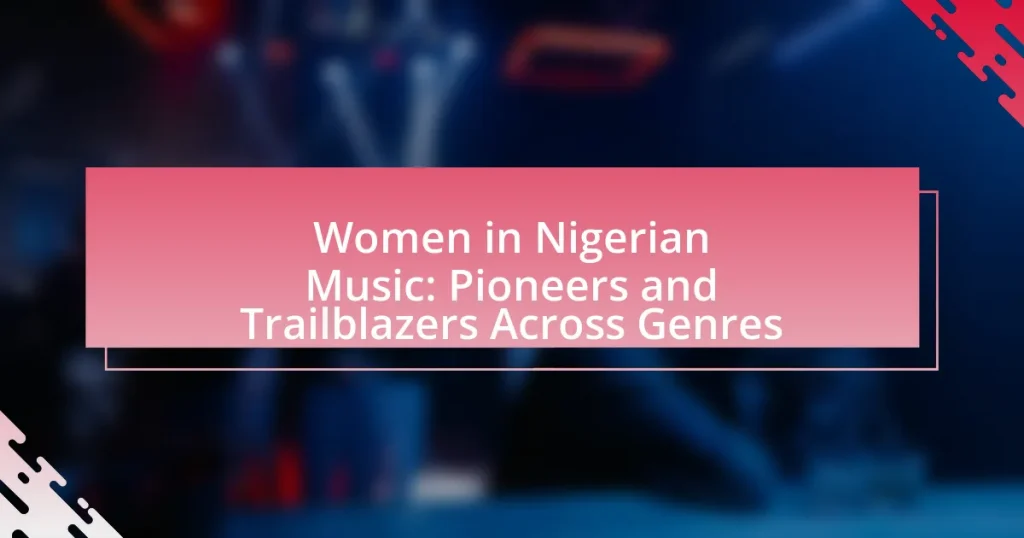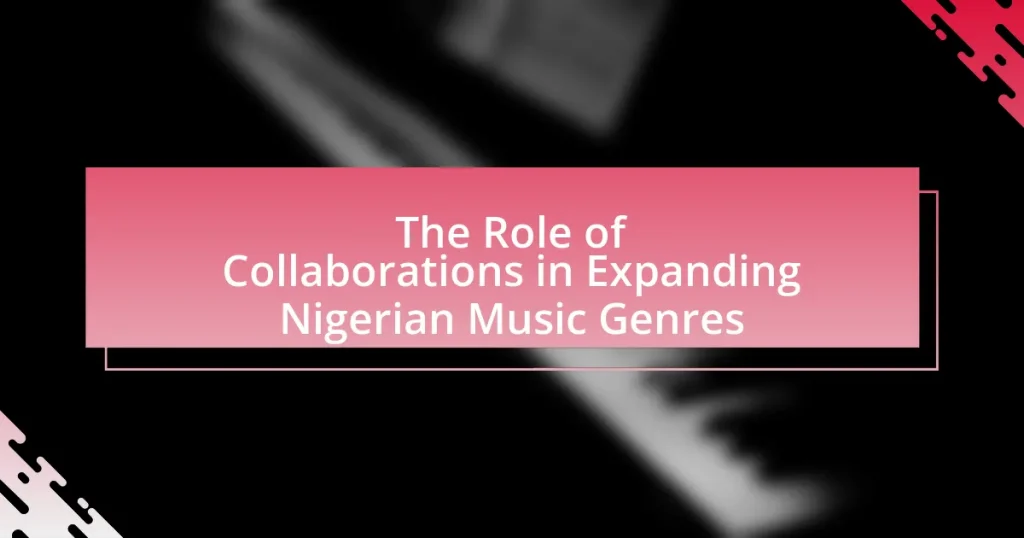The article examines the integral role of music in Nigerian film, particularly within the context of Nollywood, highlighting its significance in storytelling, emotional engagement, and cultural representation. It discusses how various musical genres, including Afrobeats, Highlife, and traditional music, enhance narratives and reflect Nigeria’s diverse cultural identity. The article also explores the impact of music on audience perceptions, emotional responses, and the overall cinematic experience, while addressing the collaboration between filmmakers and musicians and the challenges faced in integrating music into film production. Additionally, it considers future trends in music within Nigerian cinema, emphasizing the influence of technology and emerging artists on soundtracks.
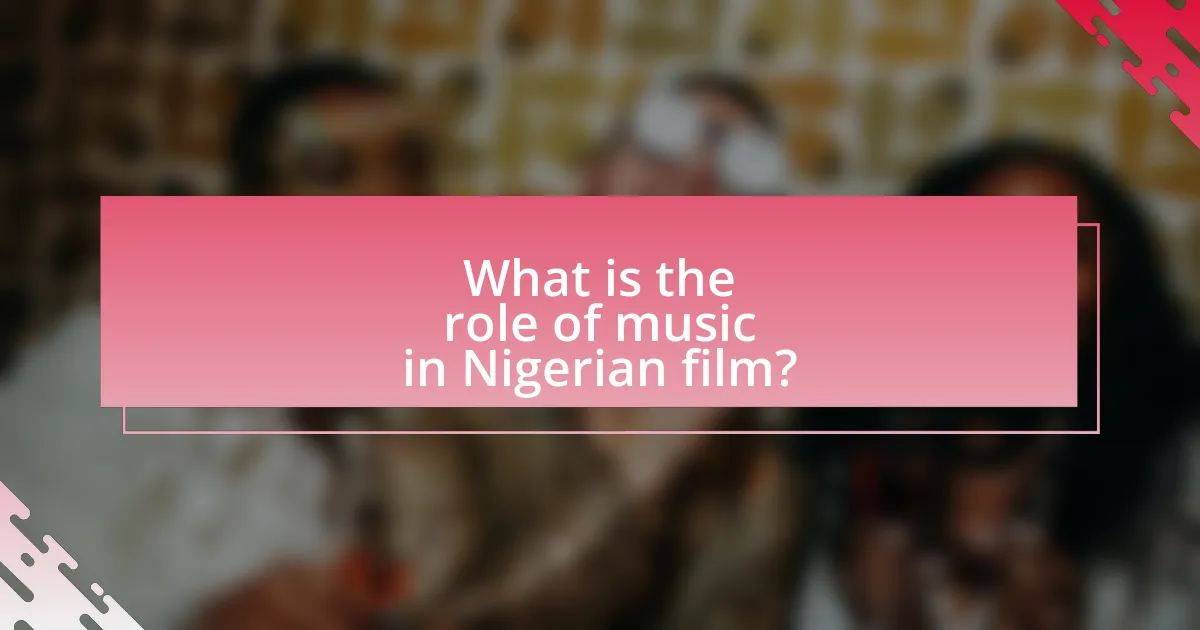
What is the role of music in Nigerian film?
Music plays a crucial role in Nigerian film by enhancing storytelling, evoking emotions, and reflecting cultural identity. In Nigerian cinema, known as Nollywood, music is integrated into narratives to underscore dramatic moments, create atmosphere, and connect audiences to the characters’ experiences. For instance, traditional music often accompanies scenes that depict cultural rituals or celebrations, reinforcing the cultural context and authenticity of the film. Additionally, popular music genres, such as Afrobeats, are frequently used to appeal to contemporary audiences, making the films more relatable and engaging. This integration of music not only enriches the cinematic experience but also serves as a vehicle for cultural expression, showcasing Nigeria’s diverse musical heritage.
How does music enhance storytelling in Nigerian cinema?
Music enhances storytelling in Nigerian cinema by creating emotional depth and cultural resonance. It serves as a narrative device that underscores themes, character emotions, and plot developments, effectively guiding the audience’s emotional response. For instance, traditional Nigerian music often reflects the cultural context of the story, enriching the viewer’s understanding of the characters’ backgrounds and motivations. Additionally, studies have shown that soundtracks in films like “The Wedding Party” and “Lionheart” significantly contribute to audience engagement, making the viewing experience more immersive and relatable. This integration of music not only elevates the storytelling but also preserves and promotes Nigerian cultural heritage through its diverse musical styles.
What are the different musical genres used in Nigerian films?
Nigerian films utilize various musical genres, including Afrobeats, Highlife, Juju, Gospel, and Hip Hop. Afrobeats, characterized by its fusion of African rhythms and global music styles, is prevalent in contemporary Nigerian cinema, enhancing the storytelling with its vibrant sound. Highlife, rooted in Ghanaian music but popular in Nigeria, often features in films to evoke nostalgia and cultural pride. Juju music, known for its use of traditional instruments and storytelling, adds a rich cultural layer to narratives. Gospel music is frequently incorporated to reflect themes of faith and spirituality, resonating with audiences. Lastly, Hip Hop, representing modern youth culture, is used to connect with younger viewers and address contemporary social issues. These genres collectively contribute to the cultural richness and emotional depth of Nigerian films, making music an integral part of the cinematic experience.
How does music influence the emotional tone of a film?
Music significantly influences the emotional tone of a film by enhancing the audience’s emotional response and guiding their interpretation of scenes. For instance, a suspenseful score can heighten tension during a climactic moment, while a soft melody can evoke feelings of nostalgia or sadness. Research indicates that music can alter viewers’ perceptions of characters and plot, as demonstrated in studies where participants reported different emotional reactions based on the accompanying soundtrack. This underscores the critical role music plays in shaping the overall emotional landscape of a film, particularly in the context of Nigerian cinema, where traditional music often reflects cultural narratives and emotional depth.
Why is music considered a cultural element in Nigerian films?
Music is considered a cultural element in Nigerian films because it reflects the diverse traditions, languages, and social values of various ethnic groups in Nigeria. The integration of indigenous music styles, such as Afrobeat and Highlife, enhances storytelling by evoking emotions and connecting audiences to their cultural heritage. For instance, films like “Osuofia in London” utilize traditional music to underscore cultural identity and societal issues, demonstrating how music serves as a narrative device that resonates with viewers. This cultural representation through music not only enriches the cinematic experience but also preserves and promotes Nigeria’s rich musical heritage.
How does music reflect Nigerian cultural identity?
Music reflects Nigerian cultural identity by serving as a medium for storytelling, preserving traditions, and expressing social values. In Nigeria, diverse musical genres such as Afrobeat, Highlife, and Juju music incorporate indigenous languages, rhythms, and instruments, showcasing the country’s rich cultural heritage. For instance, Fela Kuti’s Afrobeat not only entertains but also critiques political issues, embodying the spirit of resistance and social consciousness prevalent in Nigerian society. Additionally, traditional music often accompanies rituals and ceremonies, reinforcing communal bonds and cultural practices. This interplay between music and cultural identity is evident in the way songs convey historical narratives and celebrate ethnic diversity, making music a vital component of Nigeria’s cultural landscape.
What role does traditional music play in contemporary Nigerian cinema?
Traditional music plays a significant role in contemporary Nigerian cinema by enhancing storytelling and cultural representation. It serves as a vital tool for conveying emotions, setting the tone, and connecting audiences to their cultural heritage. For instance, films like “The Wedding Party” and “Lionheart” incorporate traditional music to reflect Nigerian customs and values, thereby enriching the viewing experience. Additionally, traditional music often features in soundtracks, helping to evoke nostalgia and a sense of identity among viewers, which is crucial in a diverse nation like Nigeria where over 250 ethnic groups exist. This integration of traditional music not only preserves cultural narratives but also promotes them to a global audience, showcasing Nigeria’s rich artistic heritage.
How does music contribute to the audience’s experience in Nigerian films?
Music significantly enhances the audience’s experience in Nigerian films by evoking emotions, setting the cultural context, and reinforcing narrative themes. The integration of traditional and contemporary musical elements resonates with viewers, creating a deeper connection to the story and characters. For instance, the use of indigenous sounds and rhythms can evoke nostalgia and cultural pride, while contemporary genres may appeal to younger audiences, bridging generational gaps. Research indicates that music in film can influence emotional responses; a study by the University of Lagos found that audiences reported heightened emotional engagement when music aligned with the film’s themes. This demonstrates that music is not merely an accompaniment but a vital component that shapes the overall viewing experience in Nigerian cinema.
What impact does music have on audience engagement?
Music significantly enhances audience engagement by evoking emotions and creating a memorable experience. In Nigerian films, music serves as a cultural connector, reinforcing themes and narratives, which increases viewers’ emotional investment. Research indicates that films with effective musical scores can improve audience recall and emotional responses, leading to a more immersive viewing experience. For instance, a study published in the Journal of Media Psychology found that background music can influence viewers’ perceptions and emotional reactions, thereby enhancing overall engagement with the film.
How does music shape audience perceptions of characters?
Music shapes audience perceptions of characters by influencing emotional responses and establishing context within narratives. In Nigerian films, specific musical themes or motifs are often associated with particular characters, guiding viewers’ interpretations of their personalities and motivations. For instance, the use of traditional instruments can evoke cultural identity, while contemporary genres may signal modernity or conflict. Research indicates that music can enhance empathy towards characters, as demonstrated in studies showing that audiences often feel more connected to characters when their emotional states are underscored by appropriate musical cues. This relationship between music and character perception is crucial in shaping the overall viewing experience in Nigerian cinema.
In what ways does music create a sense of place in films?
Music creates a sense of place in films by enhancing the emotional landscape and cultural context of the narrative. In Nigerian films, traditional music often reflects local customs, languages, and social dynamics, grounding the viewer in a specific geographical and cultural setting. For example, the use of indigenous instruments and rhythms can evoke the atmosphere of rural communities, while contemporary genres may represent urban life, thus providing an auditory backdrop that aligns with the visual elements of the film. This alignment helps audiences connect with the setting on a deeper level, as evidenced by the use of highlife music in films set in urban Nigeria, which resonates with the experiences of city dwellers.
Why is the collaboration between filmmakers and musicians important?
Collaboration between filmmakers and musicians is important because it enhances the emotional depth and storytelling of films. Music serves as a powerful tool to evoke feelings, set the tone, and create a memorable atmosphere that complements the visual narrative. In Nigerian cinema, for instance, the integration of traditional music with contemporary soundtracks has been shown to resonate with audiences, reflecting cultural identity and enhancing viewer engagement. This synergy not only enriches the cinematic experience but also promotes the cultural heritage of Nigeria, as seen in films that incorporate indigenous sounds and rhythms, thereby fostering a deeper connection between the film and its audience.
How do soundtracks influence the marketing of Nigerian films?
Soundtracks significantly influence the marketing of Nigerian films by enhancing emotional engagement and cultural resonance with audiences. The integration of popular music genres, such as Afrobeats and traditional sounds, creates a relatable atmosphere that attracts viewers. For instance, films like “The Wedding Party” effectively utilized soundtracks featuring well-known Nigerian artists, which not only boosted the film’s appeal but also increased its visibility through music video promotions and social media sharing. This strategy leverages the existing fan base of the artists, thereby expanding the film’s reach and marketability. Additionally, soundtracks often become a part of the cultural conversation, further embedding the film within the social fabric of Nigerian society, which can lead to increased box office sales and streaming views.
What are the challenges faced in integrating music into film production?
Integrating music into film production presents several challenges, including budget constraints, cultural relevance, and synchronization issues. Budget constraints often limit the ability to hire skilled composers or acquire rights to popular songs, which can affect the overall quality of the film’s soundtrack. Cultural relevance is crucial, especially in Nigerian films, where music must resonate with local audiences; failing to do so can lead to a disconnect between the film and its viewers. Synchronization issues arise when aligning music with visual elements, requiring precise timing to enhance emotional impact, which can be technically demanding. These challenges highlight the complexities involved in effectively incorporating music into film production.
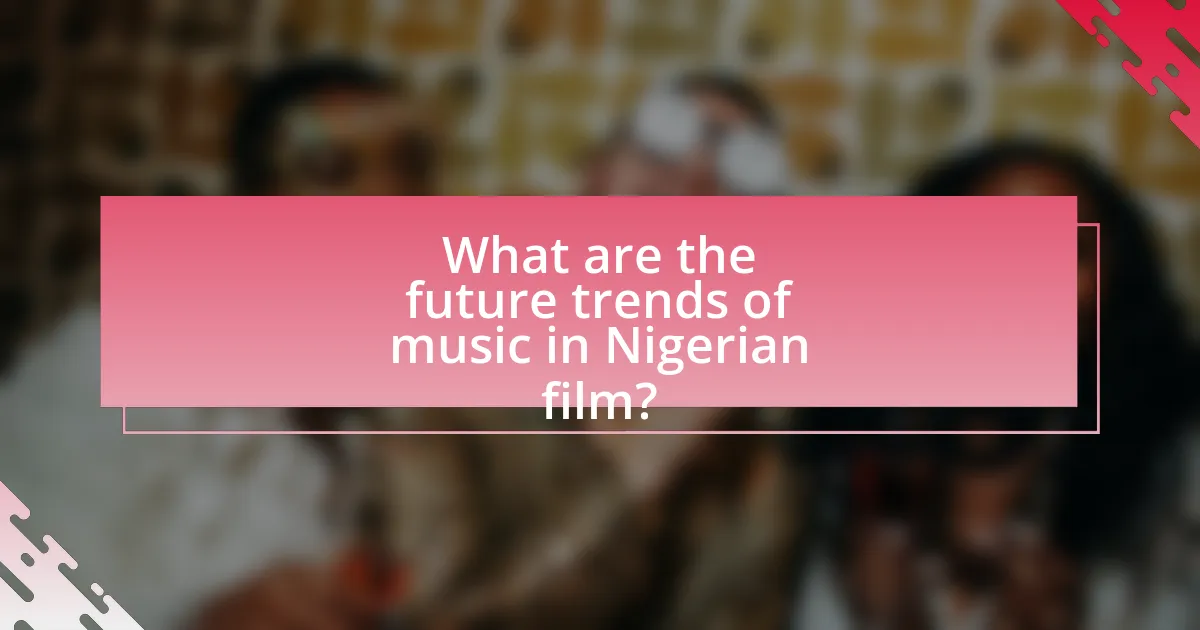
What are the future trends of music in Nigerian film?
The future trends of music in Nigerian film are expected to include increased integration of contemporary genres, such as Afrobeats and hip-hop, into soundtracks, reflecting the evolving musical landscape. This shift is driven by the growing popularity of these genres both locally and internationally, as evidenced by the global success of Nigerian artists like Burna Boy and Wizkid. Additionally, there will likely be a rise in collaborations between filmmakers and musicians, enhancing storytelling through music and creating a more immersive experience for audiences. The use of technology in music production and distribution will also play a significant role, allowing for innovative soundscapes and wider accessibility of soundtracks.
How is technology changing the way music is used in films?
Technology is transforming the use of music in films by enabling innovative sound design, enhancing accessibility, and facilitating real-time collaboration among creators. Digital audio workstations allow filmmakers to compose, edit, and mix music with precision, leading to more complex and layered soundtracks. Streaming platforms and digital distribution have expanded access to diverse musical styles, allowing filmmakers to incorporate a wider range of cultural influences, particularly in Nigerian cinema, where traditional sounds can be blended with contemporary genres. Additionally, advancements in artificial intelligence and machine learning are enabling personalized soundtracks that adapt to viewer preferences, further enriching the cinematic experience.
What role do digital platforms play in music distribution for films?
Digital platforms serve as crucial intermediaries in the distribution of music for films, enabling filmmakers to reach wider audiences efficiently. These platforms, such as Spotify, Apple Music, and YouTube, facilitate the streaming and purchasing of soundtracks, thereby increasing accessibility for consumers. According to a report by the International Federation of the Phonographic Industry (IFPI), digital music revenues accounted for 62% of the global music market in 2020, highlighting the significant impact of these platforms on music distribution. Furthermore, digital platforms allow for targeted marketing and promotional strategies, which can enhance the visibility of film soundtracks and contribute to their commercial success.
How are emerging artists influencing the sound of Nigerian cinema?
Emerging artists are significantly influencing the sound of Nigerian cinema by introducing innovative musical styles and diverse genres that reflect contemporary cultural narratives. These artists often blend traditional Nigerian music with global influences, creating unique soundtracks that resonate with younger audiences. For instance, the incorporation of Afrobeats and hip-hop elements in film scores has become increasingly prevalent, enhancing the emotional depth and relatability of cinematic stories. This shift is evidenced by the success of films like “The Wedding Party,” which features a soundtrack that integrates modern Nigerian sounds, appealing to both local and international viewers. As a result, emerging artists are not only shaping the auditory experience of Nigerian films but also contributing to the broader cultural dialogue within the industry.
What best practices can filmmakers adopt for effective music integration?
Filmmakers can adopt several best practices for effective music integration, including aligning music with the narrative, utilizing culturally relevant sounds, and ensuring seamless transitions between scenes. Aligning music with the narrative enhances emotional engagement; for instance, a study by the University of Southern California found that music significantly influences audience perception of character emotions. Utilizing culturally relevant sounds, particularly in Nigerian films, can deepen cultural resonance and authenticity, as evidenced by the success of films like “The Wedding Party,” which effectively incorporated local music styles. Lastly, ensuring seamless transitions between scenes maintains the film’s flow and keeps the audience immersed, as demonstrated in the editing techniques used in acclaimed films.
How can filmmakers collaborate with musicians to enhance film quality?
Filmmakers can collaborate with musicians to enhance film quality by integrating original scores and soundtracks that reflect the film’s cultural context. This collaboration allows for a more immersive experience, as music can evoke emotions and set the tone for scenes, thereby enriching storytelling. For instance, in Nigerian cinema, the use of traditional instruments and local musical styles can resonate with audiences, creating a deeper connection to the narrative. Research indicates that films with well-composed music often receive higher audience ratings, demonstrating the significant impact of music on viewer engagement and overall film success.
What strategies can be employed to preserve traditional music in films?
To preserve traditional music in films, filmmakers can integrate authentic traditional music into soundtracks, ensuring cultural representation and authenticity. This can be achieved by collaborating with local musicians and cultural experts who understand the nuances of traditional music, thereby maintaining its integrity. For instance, the incorporation of indigenous instruments and styles in film scores can enhance the cultural narrative, as seen in films like “The Wedding Party,” which features traditional Nigerian music to reflect its cultural setting. Additionally, filmmakers can document traditional music practices through behind-the-scenes features or educational content, promoting awareness and appreciation among audiences. This approach not only enriches the film’s cultural context but also contributes to the preservation of traditional music for future generations.
